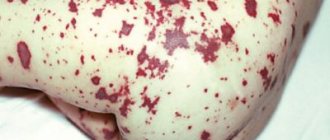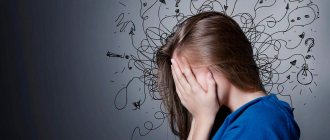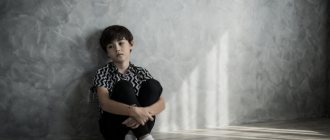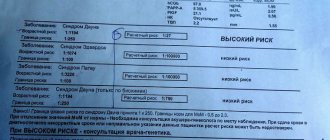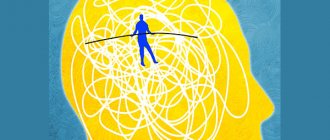Schizophrenia in children is an extremely rare phenomenon.
It usually “blooms” during adolescence. In psychiatry, childhood schizophrenia is a disease that manifests itself before the age of 12. The disorder in children is characterized by some specificity of symptoms and difficulty in diagnosis. The vigilance of parents and a qualified specialist will help to recognize the disease in time and begin timely therapy.
What causes the disorder
It is immediately worth noting that the exact, final cause of childhood schizophrenia has not yet been clarified, and the probable ones can be defined as combined. Both biological and social factors play a role here.
Among the biological predisposing factors, primarily genetics and heredity are distinguished. It has been established that the majority of children suffering from the disorder have sick relatives, either immediate or even secondary.
Biological causes also include damage to the central nervous system. Damage to brain structure plays an important role in the manifestation of the disorder. They are divided into perinatal and postnatal.
Perinatal risk factors are defects acquired in the womb. They can develop due to:
- intrauterine fetal hypoxia;
- intrauterine infections;
- placental abruption;
- lack of nutrition;
- toxic effects on the fetus - maternal abuse of alcohol and drugs during pregnancy; taking medications prohibited for pregnant women; if the pregnant woman has been exposed to toxic substances.
Postnatal risk factors include those that affect the child after birth. Traumatic brain injuries play a special role here. This group also includes neuroinfections, that is, infections that destroy brain tissue: encephalitis, meningitis, neurosyphilis. Conditions that cause brain hypoxia predispose to the development of the disease.
But all these reasons may be powerless if the child is surrounded by a prosperous social environment.
The risk appears if a child grows up and is brought up in an unfriendly, oppressive atmosphere. This concerns the violence to which the child is subjected: beatings, aggression from parents, systematic accusations, inadequate assessment of actions. Child abuse often occurs in families where parents are drug addicts or alcohol abusers.
Another model of behavior is when parents raise their child with excessive severity, make excessive demands on him, dictate their preferences, and establish increased control. That is, education from the cycle: “a step to the left, a step to the right - execution.”
In another family, the child seems to live and be raised according to the rules, but the relationship between the parents does not work out. Constant quarrels, scandals, misunderstandings between spouses leave a negative imprint on the child’s psyche, especially if he witnesses violence.
But it also happens that the family is quite prosperous, the relationships between its members are positive and friendly, but the baby was exposed to a severe stress factor. This could be the death of a loved one, violence, or a child witnessing a terrible event. In this case, there is also a risk of manifestation of the disorder.
Narrated by Natalya Kerre, defectologist, family consultant and author of the book “Special Children.”
Special children: How to give a happy life to a child with developmental disabilities
Natalia Kerre
For a long time, childhood schizophrenia was considered as a separate disease, not related to schizophrenia in adults. Now most researchers agree that schizophrenia, which develops in childhood, is a more severe form of the same schizophrenia that affects adults, and not an independent disease.
What could be a possible sign of the development of schizophrenia in a child and when should you contact a child psychiatrist?
Early childhood schizophrenia
Symptoms and signs of childhood schizophrenia have many similarities with its course in adults. But, nevertheless, they are not without specific manifestations, which, it must be said, complicate its diagnosis.
The disease is divided into three types, covering different age periods:
- schizophrenia of early age – from 0 to 3 years;
- preschool age - from 3 to 5–7 years;
- school age - after 7 years;
Surprisingly, the first signs of schizophrenia in children can be noticed already in infancy, in the first year of life, although during this period they appear quite rarely. The difficulty is this: they are so vague and atypical that not every mother can suspect the onset of a mental disorder in them:
- the child is lethargic and inactive. Doesn't respond to toys. Doesn't wake up for feeding, doesn't cry before feeding. It seems that he does not feel hungry. Shows emotional coldness towards the mother: does not smile at her, does not reach out to her. Indifferent to uncomfortable conditions;
- motor excitation. Occurs during the daytime. The child lies in the crib and jerks his arms and legs. But these movements are not similar to normal age-related motor activity. They are monotonous, reminiscent of automatisms. They occur against a reduced emotional background, that is, the baby does not show any emotions. Motor skills do not become more difficult with age. Moreover, those already acquired are lost;
- affective disorders. Excessive tearfulness appears. The baby cries both day and night. Anxiety and crying occur in periods, alternating with phases of relative calm. For example, anxiety attacks can be repeated 2-3 times during the night.
Symptoms of schizophrenia in children of the second or third year of life are accompanied, first of all, by the extinction of emotions. Children become inactive, unsmiling, and unemotional. In some cases, children who have already begun to walk lose this ability. They begin to crawl, their movements acquire a chaotic direction, developmentally corresponding to one month of age.
On the other hand, such kids become excited. They are often in a state of constant, aimless walking, in a circle or in the form of a pendulum, swaying from side to side. At the same time, the face becomes detached or the children begin to make different grimaces. Despite walking for a long time (1 hour or more), they do not get tired. It becomes very difficult to stop them from aimless desires. They break free and continue the process.
Disorder at this age can also be expressed in unreasonable laughter or crying, in disorganized running and jumping.
Sharp excitement gives way to lethargy. Children tend to lie down in a quiet, distant place: under the bed, in the corner. They take an unnatural pose. It is very difficult to take them out for a walk; you have to do it by force. Sleep is also disturbed. Kids wake up in the middle of the night and spend a long time without sleep.
In general, the picture of the disease in children under 3 years of age comes down to aimless movements and automatisms, and regression in development. Against the background of a pathological condition, fears arise that have no basis. This could be a fear of any object: cars, trees, etc. When a frightening object comes into view, the child becomes anxious and excited. But once you remove it from sight, the baby’s condition returns to normal.
THE FIRST SIGNS OF SCHIZOPHRENIA IN CHILDREN OF DIFFERENT AGE GROUPS - author Kerre N.O.
Kerre N.O. Speech pathologist, family consultant
For a long time, childhood schizophrenia was considered as a separate disease, not related to schizophrenia in adults. But researchers now agree that childhood-onset schizophrenia appears to be a more severe form of the same schizophrenia that affects adults, rather than a separate disease.
What could be a possible sign of the development of schizophrenia in a child and requires consultation with a child psychiatrist?
1. Strange fantasies, characterized by particular persistence, the child does not make a difference between himself and the character he is roleplaying: calling himself a “kitty”, he takes food only from bowls on the floor, to the question: “Who are you?” does not say his name, does not say that he is a boy or a girl, but insists that he is a “cat”. Older children who speak may ask to be called by other names and talk about invisible things to friends who come to them.
2. Incomprehensible fears - the child either himself cannot explain what he is afraid of, or, on the contrary, clearly describes “monsters” or people who come to him in the evenings, can clearly show where they stand. He may stubbornly refuse to answer the question of what he is afraid of.
3. The level of everyday and social functioning has deteriorated significantly: the child has stopped taking care of himself and washing himself; prefers spending solitary time in his room to playing with friends, although he used to be sociable; performance has deteriorated in developmental classes, in the kindergarten or at school; the child seems to “become stupid” and begins to behave in accordance with an earlier age.
4. During a conversation, the child interrupts the conversation and looks around, as if listening to something, while losing the thread of the conversation. Sometimes speech becomes incoherent. Complains of voices in his head that shout, point, comment, etc. Simplification and “disintegration” of speech may be observed.
5. Unmotivated aggression, cruelty; emotions are smoothed out, flattened, becoming less and less distinguishable. The child may demonstrate emotions that are inappropriate to the situation, for example, laughing when sad news is reported.
6. In the drawings, a bright contrasting color appears that does not correspond to the plot (blue grass, orange sky, etc.), contrary to popular belief, the black color in the drawings does not always indicate the development of schizophrenia, more often it indicates depressive disorders. Repeated, frightening scenes may be observed: creatures with teeth, severed limbs, overly large, clearly defined eyes.
Schizophrenia is quite rare among children under 12 years of age, but the incidence increases during adolescence. In boys, schizophrenia can develop at an earlier age (2-4 years). Children with a predisposition to schizophrenia usually initially have a number of characteristics. While cognitive functions are preserved and the level of intelligence is normal, the area of practical activity suffers when children cannot perform simple self-care actions. Such children often avoid anything related to physical activity and prefer calm, “sedentary” games. Children are selective in communication and do not know how to stand up for themselves. From an early age, long periods of melancholy, “aching” mood can be observed without any apparent external cause. When problematic situations arise, children are more likely to withdraw into themselves rather than express an emotional reaction.
Depending on age, the first signs of schizophrenia can manifest themselves in different ways:
Infancy - focused, "serious" look, usually uncharacteristic of infants. Sleep is short, the child sleeps several hours a day. Sometimes it is impossible to determine what the child is watching. Some children experience delays in speech and basic motor skills. Infants are hypersensitive to loud noises, lethargic, easily startled, irritated, cry, and are difficult to calm. Children are characterized by emotional coldness towards their parents; they are not happy when they are hugged or picked up.
1-3 years - motor characteristics: monotonous excitement, walking in a circle or from side to side, impulsiveness, unmotivated laughter and tears, the child may suddenly break away and run away. Often there are attacks of fear without external visible causes, which can also be accompanied by states of motor excitement.
2-3 years - object-related fears: cars, streets, strangers, which appear when a child encounters a frightening situation, object, or is reminded of it. When asked about the cause of fear, the child usually completely denies his fear and does not want to talk about this topic.
4-5 years - strange fantasies appear, the theme of which fills all the child’s conversational time. Along with periodically arising unaccountable fear, children begin to form phobias, often with an unusual theme: fire, clouds, shadows, language - their own and someone else’s, etc. Concerns arise that concern the child’s own well-being; children are afraid that something bad will happen to them: they will forget in a shopping center or kindergarten, they will become ill, they will get sick; they will be stolen. Children may also fear for the lives of their loved ones without objective reasons: “Mom will be killed,” “Dad will get sick and die,” “Grandma will be killed.” Children get tired of their anxious thoughts, but cannot stop “scrolling” them in their heads.
5-6 years - obsessions in the form of questions that children repeat many times, do not need answers to them, or require only a specific answer. Children may begin to compulsively rhyme words and create new ones, but this, like questions, becomes aimless and obsessive. Elements of “antisocial” behavior may appear: children experience an obsessive desire to utter curses, perform dangerous actions that they are prohibited from: standing on the windowsill of an open window, snatching their hand and rushing across the road, throwing objects from the balcony. There may be aggression directed at relatives, loved ones, and pets: children experience an obsessive desire to hit, pinch, bite, and spit. Some children have contrasting desires: the fear of death and the desire to look into a sewer hatch where you can fall, the fear of pain and the desire to put your hand on a hot stove. At the same age, obsessive philosophizing may arise: “abstruse” questions from the field of “astronomy”, “about life and death”, “philosophy”, “religion”. Some children of this age complain of recurring dreams with the same frightening, disturbing content. In the evening hours, at dusk, obsessions intensify, so children may have difficulty falling asleep.
6-7 years old - pronounced negativism, including towards relatives. In the presence of such “unsympathetic” people, children become anxious, fussy, and seek to cause harm: they push, pinch, hit them, and may begin to urinate or defecate in their shoes. This attitude of hostility is not explained at all (“Let him go”) or is explained strangely: “She is a stranger,” “He is black,” “Why is he looking at me.” Some children with schizophrenia experience fear and anxiety during feeding and bathing. They want to eat and immediately refuse food, while they worry, cry, scream, and do not give in to persuasion. This is not due to loss of appetite; the child experiences a feeling of hunger, and the desire to eat persists. In these cases, a persistent negative attitude towards food is formed, which is accompanied by anxiety and an inexplicable fear of eating something bad. They refuse to wash because they are “afraid of drowning or choking.” Children cannot explain the cause of fear and the logical arguments given by adults that fears are groundless do not work. In children of this age group, states of hypomania are possible, when an elevated mood with a hint of gaiety is combined with motor fussiness, and purposeful activity disintegrates. Falling asleep is disrupted, sleep becomes shorter, children stop sleeping during the day, but at the same time they do not seem to feel tired. Delusions, hallucinations and disturbances in logical thinking are extremely rare before the age of 7 years.
10-12 years old - problems concentrating, sleep is disturbed, problems appear in studies. The child begins to avoid communication and more often secludes himself in the room. Speech may become incoherent, the child begins to see or hear things that others cannot see or hear, and complains of voices in the head that order him to harm himself or his relatives. During the acute, psychotic phases of the illness, children with schizophrenia may claim to have superhuman abilities or to be constantly monitored. During a psychotic episode, the child's behavior may become unpredictable, aggression or self-harmful behavior may appear.
When diagnosing schizophrenia, as with any current disease, manifestations should be looked for not only during an acute attack, but also in the painful manifestations of the pre-attack and inter-attack periods, and it makes sense to diagnose a child after dynamic observation of him for some time. There are no specific instrumental and laboratory diagnostic tests for schizophrenia; diagnosis is based on observation of symptoms. In this case, the possibility of drug use, exposure to toxic substances, injuries and brain tumors should be excluded. Symptoms of childhood schizophrenia are not specific. Only their relationship, the manifestation of a complex of symptoms, is specific. Signs of violations must be observed for at least 6 months. In addition, after the onset of signs of the disorder, the child must experience a significant decline in the level of functioning in one or more areas (personal, academic, etc.). An additional diagnosis of schizophrenia in the presence of another disorder (mental retardation, etc.) can be made only if delusions or hallucinations are present for at least a month.
Schizophrenia in preschool children
In children aged 3 to 7 years, the disease begins with emotional coldness. Children become indifferent to what is happening, limit communication with peers, and do not show warm feelings towards their parents. Previously acquired knowledge and skills are lost, interest in favorite activities and toys disappears.
Little patients become capricious, and their mood undergoes sudden changes and fluctuates over a wide range.
Children do not show interest in their appearance and refuse to perform daily hygiene procedures. They become sloppy, may wear dirty clothes, and go to sleep on the floor.
Behavior also changes. In their actions they can display the manners of younger children. For example, a child who was already quite fluent in using a spoon and fork, suddenly begins to eat with his hands, scatters food, and crumbles it.
He spends almost all his time alone, fencing himself off from people. It is difficult to tolerate innovations in his regime. His games become primitive, losing their plot. They come down to feeling objects and toys, sniffing them. The theme of the game does not matter - such children are attracted only to individual actions. In other words, games take on a stereotypical character: a preschool child opens and closes the closet door, arranges objects in a certain sequence. If his work is interrupted, he becomes very angry.
The disorder has a particular impact on speech. So, if the child has already expressed his thoughts well and competently, then at the beginning of the illness one can note a violation of the semantic arrangement of words in a sentence. Gradually, speech becomes incoherent, the child is unable to clearly express his thoughts. Echolalia appears - repetition of words spoken by someone. Little by little, a full-fledged, intelligible narrative becomes incoherent and incomprehensible. Sentences are shortened, words are replaced with syllables. Soon the speech turns into incoherent babble.
As the process progresses, children show signs of catatonia. They are inhibited, frozen in one position. For example, they sit bent over and throw their head back, or lie in a fetal position. At the same time, the look is absent, they do not make contact.
The other side of catatonia is elevated mood, agitated behavior. The child jumps, laughs, fools around for no reason.
Disease syndromes
Schizophrenia in childhood manifests itself in groups of syndromes that cover absolutely all areas of the child’s activity: emotional, social, intellectual, behavioral, volitional. As a result, children lose touch with reality and exist in their own, detached, fictional world.
Apato-abulic syndrome is accompanied by lethargy, lack of initiative, and loss of interests. Behavior is characterized by monotonous, aimless, sluggish movements. Activity decreases sharply. Children lose their inherent cheerfulness. Usually they take one position, sitting like that for quite a long time: standing, lying, sitting, without changing position. Another option is to start walking or running aloofly, completely ignoring people and what is happening around them. Attention is paid to monotonous, stable processes: water flow, snowfall, the movement of fish in the aquarium. They can watch such phenomena for hours.
It is difficult to interest children in games and new toys. There is rapid satiety with any activity: they start doing something and immediately give up, losing interest. The game takes on primitive features: rolling the car back and forth, moving the toy from place to place, repeatedly tapping on the surface.
The emotional background becomes scarcer. They ignore their relatives. The parents don't seem to notice. They lose the ability to empathize with friends and loved ones. They stop expressing their own dissatisfaction or satisfaction. They ignore requests and questions asked.
Indifference is manifested in relation to food and appearance. They stop performing basic hygiene procedures. They wear dirty, torn clothes, despite the persuasion of their parents, sometimes putting things on inside out. There is a regression of basic skills. Relatively adult children, accustomed to the rules of using the toilet, begin to defecate on the floor, in their pants, while in a public place.
Speech changes, becomes quiet, meager. Children manipulate monosyllabic phrases. Identify themselves using third person pronouns. They speak indistinctly and blurredly. Gradually, speech becomes slurred. Often they stop talking altogether.
Psychopathic-like syndrome is manifested by imbalance, anxiety, and unstable mood. The emotional background of children becomes quite labile. They perceive the most insignificant stimuli acutely. They fall to the floor and roll around on the floor. They scream and wave their arms and legs chaotically. Usually such reactions are a response to an objectionable request.
Children are aggressive. They are rude to others, capable of spitting, hitting, pushing people. There are cases of raptoid state: acute fear makes children's behavior inappropriate. The patient begins to rush about, run aimlessly, and cry. Throws himself at passers-by, tears off clothes. He falls into the mud, rolls around in it, then suddenly jumps up and runs on.
Self-aggression is born. Patients often self-harm: they bite, scratch, and hit themselves. Increased sensitivity appears, provoked by loud sounds and bright light. Sometimes kids are annoyed by their own clothes: children actually tear them off.
Sleep is disturbed, it becomes superficial and anxious. The child has difficulty falling asleep asking an adult to lie next to him. They wake up in the middle of the night and cannot sleep until the morning.
Paranoid syndrome is defined by positive symptoms: delusions, hallucinations, often of an auditory or tactile nature.
Pseudoorganic syndrome is the end result of the course of the disease. It manifests itself as schism, splitting of consciousness. It is characterized by a violation of all cognitive functions: perception, memory, thinking, intelligence.
Productive symptoms of childhood schizophrenia
Schizophrenia in preschool children manifests itself in the form of pathological fantasizing. What distinguishes it from typical children's fantasies is the unreality and persistence of the imaginary. Painful fantasies are pretentious in their themes, and are accompanied by changes in behavior.
The child is reincarnated into some object and is able to remain in his new role for several days. For example, a boy, seeing himself as a car, twisted his arms and moved his legs, imitating its driving. I stopped periodically to refuel as I was running out of gas. Everyday needs were carried out automatically, and then under the pressure of adults.
Fantasies in the form of fairy-tale creatures, monsters, and dragons are common.
Productive symptoms in preschoolers are also represented by delusions and hallucinations. But they are less pronounced than in school-age children and adults.
Hallucinations can be visual, auditory, or oral in nature. Visual hallucinations usually appear at the moment of falling asleep or waking up. The child develops a feeling of fear and anxiety. He peers into the room, directs his gaze to a certain part of the room. He says there is a blue wolf standing there, there are a lot of spiders on the ceiling, or a snake is crawling on the bed. He sees a glowing face and a black paw.
Auditory hallucinations in young children rarely involve voices in the head. More often they “come” in the form of a rooster’s crow, the striking of a clock, someone’s crying, the voice of evil forces: a witch, an evil sorcerer, villains from cartoons.
Oral quirks include sensations such as a burning sensation in the mouth, the presence of an object, hair, or crumbs.
Among delusional ideas, the delusion of persecution comes to the fore.
School age schizophrenia
Starting from the age of 6–7 years, the child spends most of his time at school. Therefore, the onset of the disease can be determined by the nature of the educational activity. Such children are noticeably behind in mastering educational material compared to their peers. All their cognitive functions suffer, their voluntary attention is poorly developed, that is, it is very difficult to keep it focused on the material being taught. But involuntary attention in such children, on the contrary, is more pronounced.
The problem of perception lies in understanding the integrity of the picture. It is difficult for a child to grasp the general meaning. He breaks down what he says or sees into separate parts. Memory is selective. Only that which sincerely interests the sick child is remembered. It is almost impossible to force him to learn educational material if he does not want to.
Such children drop out of the life of the team. They remain aloof and withdraw into their own world. They develop strange passions and hobbies. They are characterized by fragmented thinking, reasoning, and separation from reality. Their thoughts take on a dark and frightening character. Children are suspicious, look for a trick in everything, and may assume that everyone is watching them. Gradually they become autistic, separate from the world around them, and withdraw into themselves.
Abulia develops - lack of will. It is difficult for a child to persuade himself to engage in activities, although he understands the need for this. He spends most of his time in bed, refuses to go to school, and does not communicate with friends.
As the disease progresses, delusions and hallucinations join the symptoms. The latter appear in the form of voices that frighten and incline to a certain action. Often children are silent about their appearance.
Gradually, the disease takes on one of its forms. Childhood schizophrenia manifests itself in the following forms:
- sluggish – the most common form of the disorder. Its early sign can be superpowers in any area - drawing, mathematics, music. But over time they are lost. Children suffering from this form of the disease are characterized by pathological fantasies, obsessive fears, and fanciful hobbies;
- paroxysmal - progressive - the symptoms of the disease are not clearly expressed. And it manifests itself in periods. But it leads to irreversible consequences like schizophrenia;
- paranoid – occurs less frequently than other forms. Among its symptoms are delusions of persecution, poisoning, malignant fantasies and fears. Expressed emotional coldness;
- hebephrenic – excited, aggressive behavior. Characteristic are antics, grimacing, pretentiousness;
- catatonic - taking pretentious poses and freezing in them or increased impulsiveness and excitability in actions. Meaningless speech, imitating movements, words of other people.

